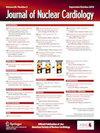轻度至中度主动脉瓣狭窄患者的心肌缺血:与心脏重塑和不良事件的相互作用。
IF 2.7
4区 医学
Q2 CARDIAC & CARDIOVASCULAR SYSTEMS
引用次数: 0
摘要
背景:主动脉瓣狭窄(AVS)与心肌灌注异常之间的关系尚未完全定性。我们试图评估轻度至中度 AVS 患者心肌缺血的预测因素及其与长期预后的关系:方法:89 名轻度至中度 AVS 患者(峰值速度在 2.6-4.0 米/秒之间,主动脉瓣面积大于 0.6 平方厘米/平方米),左心室功能保留,冠状动脉正常(28 名患者)或无阻塞性冠状动脉疾病(115 克/平方米(男性)或 95 克/平方米(女性)],或二维超声心动图检查确定左心室同心重塑(相对室壁厚度大于 0.42):轻度和中度 AVS 患者分别为 40 人(45%)和 49 人(55%)。分别有 50 例(56%)、17 例(19%)和 22 例(25%)患者左心室几何形状正常、左心室同心重构和左心室肥厚。左心室重构与诱导性缺血之间存在相互作用,左心室几何形状正常(3±3)、同心重构(4±2)和左心室肥厚(7±2)的患者的 SDS 值逐渐升高(PConclusions.Com):轻度至中度 AVS 患者的心肌缺血与左心室不良重塑的严重程度相关。LVH 和缺血患者发生 AE 的风险增加。本文章由计算机程序翻译,如有差异,请以英文原文为准。
Myocardial ischemia in patients with mild-to-moderate aortic stenosis: Interaction with cardiac remodeling and adverse events
Background
The association between aortic valve stenosis (AVS) and myocardial perfusion abnormalities has been incompletely characterized. We sought to assess the predictors of myocardial ischemia in patients with mild-to-moderate AVS, and its relationship with long-term prognosis.
Methods
Eighty-nine patients with mild-to-moderate AVS (peak velocity between 2.6 and 4.0 m/second and aortic valve area > .6 cm2/m2), preserved left ventricular (LV) function, and either normal coronary arteries (28 patients) or non-obstructive coronary artery disease (<50% stenosis; 61 patients) were individuated. Myocardial perfusion imaging was performed using a cadmium–zinc–telluride camera, and the summed difference score (SDS) was computed. The presence of either LV hypertrophy (LVH) (LV mass index [LVMI] > 115 g/m2 [males] or 95 g/m2 [females]) or concentric LV remodeling (relative wall thickness: >.42) was determined at two-dimensional echocardiography.
Results
Forty (45%) and 49 (55%) patients had mild and moderate AVS, respectively. Fifty (56%), 17 (19%), and 22 (25%) patients had normal LV geometry, concentric LV remodeling, and LVH, respectively. An interaction between LV remodeling and inducible ischemia was revealed with progressively higher values of SDS in patients with normal LV geometry (3 ± 3), concentric remodeling (4 ± 2), and LVH (7 ± 2) (P < .001).
Accordingly, a moderate correlation existed between LVMI and SDS values (R: .67; P < .001). After a median follow-up of 84 ± 47 months, 27 adverse events were recorded, including 19 AV replacements and 8 deaths. On multivariable analysis, the presence of LVH (hazard ratio [HR]: 6.46; 95% confidence interval [CI]: 2.09–20.00; P = .001) and a higher SDS (HR: 1.41; 95% CI: 1.15–1.75; P = .001) were the two independent predictors of AE.
Conclusions
In patients with mild-to-moderate AVS, myocardial ischemia correlates with the severity of adverse LV remodeling. Patients with LVH and ischemia are at increased risk of AE.
求助全文
通过发布文献求助,成功后即可免费获取论文全文。
去求助
来源期刊
CiteScore
5.30
自引率
20.80%
发文量
249
审稿时长
4-8 weeks
期刊介绍:
Journal of Nuclear Cardiology is the only journal in the world devoted to this dynamic and growing subspecialty. Physicians and technologists value the Journal not only for its peer-reviewed articles, but also for its timely discussions about the current and future role of nuclear cardiology. Original articles address all aspects of nuclear cardiology, including interpretation, diagnosis, imaging equipment, and use of radiopharmaceuticals. As the official publication of the American Society of Nuclear Cardiology, the Journal also brings readers the latest information emerging from the Society''s task forces and publishes guidelines and position papers as they are adopted.

 求助内容:
求助内容: 应助结果提醒方式:
应助结果提醒方式:


